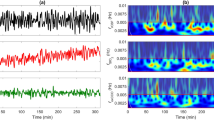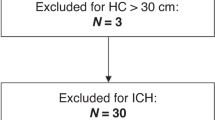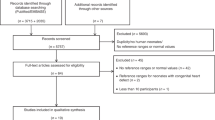Abstract
Objective
This study examined the correlation of cerebral tissue oxygen saturation (SctO2) and cerebral tissue fractional oxygen extraction (cFTOE) with gestational age (GA) and postnatal age over the first 28 days of life.
Study design
Preterm infants with birth weight (BW) <1500 g were monitored with near-infrared spectroscopy (NIRS) during the first 28 days of life. SctO2 and cFTOE measurements were analyzed using a linear mixed model.
Results
A total of 70 preterm infants were included. Mean SctO2 decreased with increasing GA; SctO2 was 76.4% and 74.6% in the first 24 h for infants 24 and 28-week GA, respectively. For infants born at 24 and 28 it decreased to 52.9% and 58.4% at 28 days of life, respectively. cFTOE increased with increasing GA and postnatal age.
Conclusions
There is an inverse relationship between SctO2 and gestational age and postnatal age but a direct relationship between cFTOE with GA and postnatal age.
This is a preview of subscription content, access via your institution
Access options
Subscribe to this journal
Receive 12 print issues and online access
$259.00 per year
only $21.58 per issue
Buy this article
- Purchase on Springer Link
- Instant access to full article PDF
Prices may be subject to local taxes which are calculated during checkout


Similar content being viewed by others
References
Janvier A, Khairy M, Kokkotis A, Cormier C, Messmer D, Barrington KJ. Apnea is associated with neurodevelopmental impairment in very low birth weight infants. J Perinatol. 2004;24:763–8.
Martin RJ, Wang K, Koroglu O, Di Fiore JM, Kc P. Intermittent hypoxic episodes in preterm infants: Do they matter? Neonatology. 2011;100:303–10.
Wolfberg AJ, du Plessis AJ. Near-infrared spectroscopy in the fetus and neonate. Clin Perinatol. 2006;33:707–28.
Wolf M, Greisen G. Advances in near-infrared spectroscopy to study the brain of the preterm and term neonate. Clin Perinatol. 2009;36:807–34.
Wyatt JS, Edwards AD, Cope M, Delpy DT, McCormick DC, Potter A, et al. Response of cerebral blood volume to changes in arterial carbon dioxide tension in preterm and term infants. Pediatr Res. 1991;29:553–7.
Almaazmi M, Schmid MB, Havers S, Reister F, Lindner W, Mayer B, et al. Cerebral near-infrared spectroscopy during transition of healthy term newborns. Neonatology. 2013;103:246–51.
Fuchs H, Lindner W, Buschko A, Almazam M, Hummler HD, Schmid MB. Brain oxygenation monitoring during neonatal resuscitation of very low birth weight infants. JPerinatol. 2012;32:356–62.
Vesoulis Z, Liao S, and Mathur A Gestational age-dependent relationship between cerebral oxygen extraction and blood pressure. Pediatric Res. [online publication 13 September 2017] https://doi.org/10.1038/pr.2017.196.
Mayera B, Pohla M, Hummlerb H and Schmidc M Cerebral oxygenation and desaturations in preterm infants – a longitudinal data analysis. J Neonatal-Perinatal Med. 10 267–73 https://doi.org/10.3233/NPM-16124.
Kissack C, Garr R, Wardle S, Weindling AM. Cerebral fractional oxygen extraction in very low birth weight infants is high when there is low left ventricular output and hypocarbia but is unaffected by hypotension. Pediatr Res. 2004;55:400–5.
Fenton TR, Kim JH. A systematic review and meta-analysis to revise the Fenton growth chart for preterm infants. BMC pediatrics. 2013;13:59.
Rais-Bahrami K, Rivera O, Short BL. Validation of a noninvasive neonatal optical cerebral oximeter in veno-venous ECMO patients with a cephalad catheter. J Perinatol. 2006;26:628–35.
Hyttel-Sorensen S, Kleiser S, Wolf M, Greisen G. Calibration of a prototype NIRS oximeter against two commercial devices on a blood-lipid phantom. Biomed Express. 2013;4:1662–72.
Philip M Dixon. Bootstrap resampling, statistical and numerical computing. Encyclopedia of Environmetrics. First published:15 September 2006. https://doi.org/10.1002/9780470057339.vab028.
Alderliesten T, Dix L, Baerts W, Caicedo A, van Huffel S, Naulaers G, et al. Reference values of regional cerebral oxygen saturation during the first 3 days of life in preterm neonates. Pediatr Res. 2016;79:55–64. https://doi.org/10.1038/pr.2015.186.
Author information
Authors and Affiliations
Contributions
MAM conceptualized study design, supervised data collection and data analysis, drafted initial version of background, methods, and discussions, edited and reviewed results sections. He reviewed and revised the final manuscript for intellectual content. MJF carried out the statistical analyses, drafted initial version of methods and results sections. He reviewed and revised the manuscript for intellectual content. SA conceptualized study design, recruited subjects, and applied NIRS to participants, collected and compiled demographic, clinical and NIRS data. He reviewed and revised the final manuscript for important intellectual content. ME-D contributed to conceptualizing study design, supervised demographic, clinical, and NIRS data collection and critically reviewed the manuscript. HJH contributed to the development of the data analysis plan, supervised and approved data analysis and critically reviewed the manuscript. HA conceptualized study design, supervised data collection, and reviewed and revised the final manuscript for important intellectual content All authors approved the final manuscript as submitted and agree to be accountable for all aspects of the work. All authors agree to be accountable for all aspects of the work in ensuring that questions related to the accuracy or integrity of any part of the work are appropriately investigated and resolved.
Corresponding author
Ethics declarations
Conflict of interest
The authors declare that they have no conflict of interest.
Additional information
Publisher’s note Springer Nature remains neutral with regard to jurisdictional claims in published maps and institutional affiliations.
Supplementary information
Rights and permissions
About this article
Cite this article
Mohamed, M.A., Frasketi, M.J., Aly, S. et al. Changes in cerebral tissue oxygenation and fractional oxygen extraction with gestational age and postnatal maturation in preterm infants. J Perinatol 41, 836–842 (2021). https://doi.org/10.1038/s41372-020-00794-w
Received:
Revised:
Accepted:
Published:
Issue Date:
DOI: https://doi.org/10.1038/s41372-020-00794-w
This article is cited by
-
Predictors of intracranial hemorrhage in neonatal patients on extracorporeal membrane oxygenation
Scientific Reports (2023)
-
Preterm infants variability in cerebral near-infrared spectroscopy measurements in the first 72-h after birth
Pediatric Research (2023)
-
Early brain and abdominal oxygenation in extremely low birth weight infants
Pediatric Research (2022)



